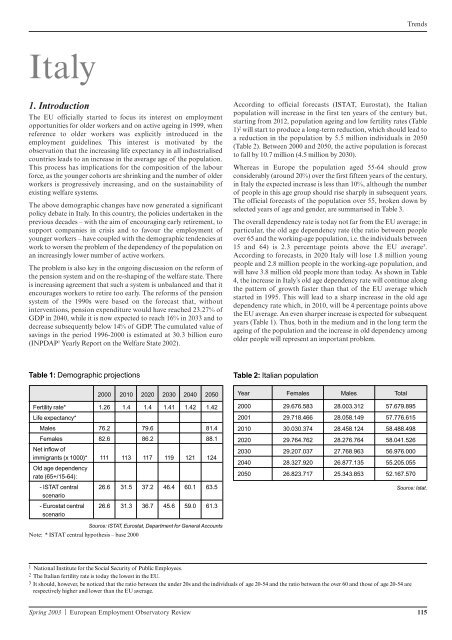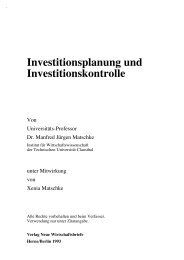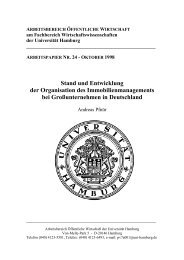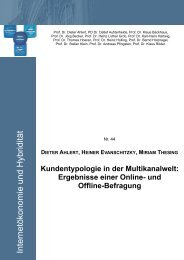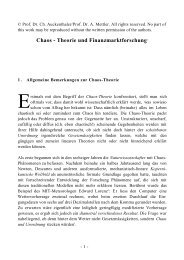FRANCE The
FRANCE The
FRANCE The
You also want an ePaper? Increase the reach of your titles
YUMPU automatically turns print PDFs into web optimized ePapers that Google loves.
Italy<br />
1. Introduction<br />
<strong>The</strong> EU officially started to focus its interest on employment<br />
opportunities for older workers and on active ageing in 1999, when<br />
reference to older workers was explicitly introduced in the<br />
employment guidelines. This interest is motivated by the<br />
observation that the increasing life expectancy in all industrialised<br />
countries leads to an increase in the average age of the population.<br />
This process has implications for the composition of the labour<br />
force, as the younger cohorts are shrinking and the number of older<br />
workers is progressively increasing, and on the sustainability of<br />
existing welfare systems.<br />
<strong>The</strong> above demographic changes have now generated a significant<br />
policy debate in Italy. In this country, the policies undertaken in the<br />
previous decades – with the aim of encouraging early retirement, to<br />
support companies in crisis and to favour the employment of<br />
younger workers – have coupled with the demographic tendencies at<br />
work to worsen the problem of the dependency of the population on<br />
an increasingly lower number of active workers.<br />
<strong>The</strong> problem is also key in the ongoing discussion on the reform of<br />
the pension system and on the re-shaping of the welfare state. <strong>The</strong>re<br />
is increasing agreement that such a system is unbalanced and that it<br />
encourages workers to retire too early. <strong>The</strong> reforms of the pension<br />
system of the 1990s were based on the forecast that, without<br />
interventions, pension expenditure would have reached 23.27% of<br />
GDP in 2040, while it is now expected to reach 16% in 2033 and to<br />
decrease subsequently below 14% of GDP. <strong>The</strong> cumulated value of<br />
savings in the period 1996-2000 is estimated at 30.3 billion euro<br />
(INPDAP1 Yearly Report on the Welfare State 2002).<br />
Table 1: Demographic projections<br />
2000 2010 2020 2030 2040 2050<br />
Fertility rate* 1.26 1.4 1.4 1.41 1.42 1.42<br />
Life expectancy*<br />
Males 76.2 79.6 81.4<br />
Females<br />
Net inflow of<br />
82.6 86.2 88.1<br />
immigrants (x 1000)*<br />
Old age dependency<br />
rate (65+/15-64):<br />
111 113 117 119 121 124<br />
- ISTAT central<br />
scenario<br />
26.6 31.5 37.2 46.4 60.1 63.5<br />
- Eurostat central<br />
scenario<br />
26.6 31.3 36.7 45.6 59.0 61.3<br />
Source: ISTAT, Eurostat, Department for General Accounts<br />
Note: * ISTAT central hypothesis – base 2000<br />
Spring 2003 | European Employment Observatory Review 115<br />
Trends<br />
According to official forecasts (ISTAT, Eurostat), the Italian<br />
population will increase in the first ten years of the century but,<br />
starting from 2012, population ageing and low fertility rates (Table<br />
1) 2 will start to produce a long-term reduction, which should lead to<br />
a reduction in the population by 5.5 million individuals in 2050<br />
(Table 2). Between 2000 and 2050, the active population is forecast<br />
to fall by 10.7 million (4.5 million by 2030).<br />
Whereas in Europe the population aged 55-64 should grow<br />
considerably (around 20%) over the first fifteen years of the century,<br />
in Italy the expected increase is less than 10%, although the number<br />
of people in this age group should rise sharply in subsequent years.<br />
<strong>The</strong> official forecasts of the population over 55, broken down by<br />
selected years of age and gender, are summarised in Table 3.<br />
<strong>The</strong> overall dependency rate is today not far from the EU average; in<br />
particular, the old age dependency rate (the ratio between people<br />
over 65 and the working-age population, i.e. the individuals between<br />
15 and 64) is 2.3 percentage points above the EU average3 .<br />
According to forecasts, in 2020 Italy will lose 1.8 million young<br />
people and 2.8 million people in the working-age population, and<br />
will have 3.8 million old people more than today. As shown in Table<br />
4, the increase in Italy’s old age dependency rate will continue along<br />
the pattern of growth faster than that of the EU average which<br />
started in 1995. This will lead to a sharp increase in the old age<br />
dependency rate which, in 2010, will be 4 percentage points above<br />
the EU average. An even sharper increase is expected for subsequent<br />
years (Table 1). Thus, both in the medium and in the long term the<br />
ageing of the population and the increase in old dependency among<br />
older people will represent an important problem.<br />
Table 2: Italian population<br />
Year Females Males Total<br />
2000 29.676.583 28.003.312 57.679.895<br />
2001 29.718.466 28.058.149 57.776.615<br />
2010 30.030.374 28.458.124 58.488.498<br />
2020 29.764.762 28.276.764 58.041.526<br />
2030 29.207.037 27.768.963 56.976.000<br />
2040 28.327.920 26.877.135 55.205.055<br />
2050 26.823.717 25.343.853 52.167.570<br />
1 National Institute for the Social Security of Public Employees.<br />
2 <strong>The</strong> Italian fertility rate is today the lowest in the EU.<br />
3 It should, however, be noticed that the ratio between the under 20s and the individuals of age 20-54 and the ratio between the over 60 and those of age 20-54 are<br />
respectively higher and lower than the EU average.<br />
Source: Istat.


